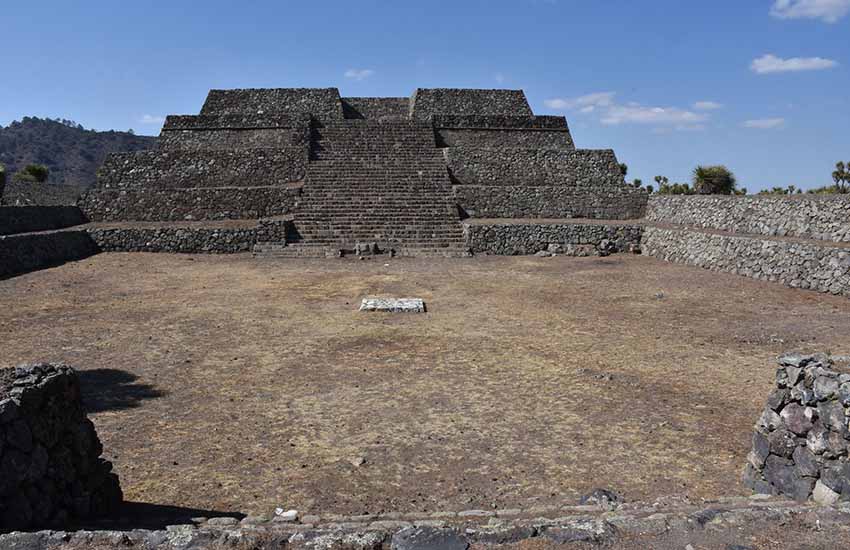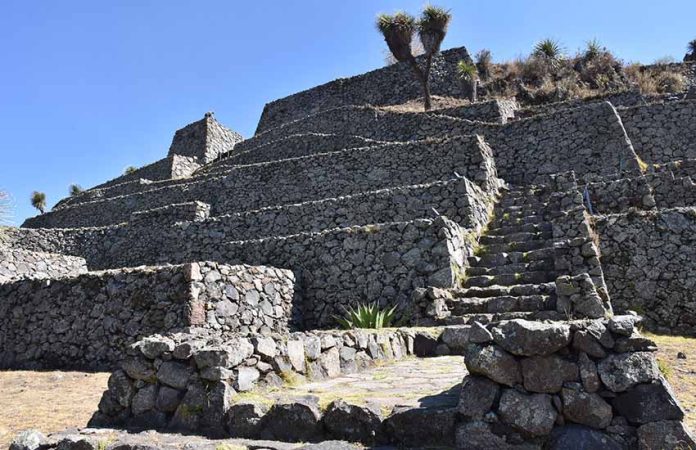Cantona, located in the northeast corner of Puebla state, is one of the most impressive pre-Hispanic ruins I’ve visited in Mexico, but for some reason, it doesn’t get nearly the attention of sites like Teotihuacán or Monte Alban.
Which is a shame because it’s only about an hour-and-a-half drive from Puebla city, and the excavated portion boasts pyramids, ball courts and numerous ancient streets and plazas. It’s well worth the trip.
The first people to populate the area where Cantona was built arrived around 1000 B.C. (its name is derived from Caltonal, a Nahuatl word meaning “House of the Sun.”). It’s not certain who these ancient people were, but they may have been Olmecas or Popolocas. It’s believed that the city eventually hosted just under 100,000 people.
![]()
Obsidian is abundant in the area, and Cantona’s residents used it in tools, weapons and decorative elements. Researchers know these early settlers traded it for other goods, a practice that eventually turned Cantona into an important regional power.
The city grew tremendously between 600 B.C. and A.D. 600, increasing from 800 acres to 2,700 acres. During this period, Cantona became a fortified city, with tall defensive walls. At its peak, around A.D. 900, Cantona occupied almost 3,700 acres.
To date, 14 pyramids, numerous altars and plazas have been excavated here. It’s believed that the city once contained 8,000 housing units.
Cantona experienced a rapid decline in population between A.D. 900 and 1000, possibly due to political upheaval. It was eventually abandoned completely by around the year 1050, but its existence had stretched over 2,000 years, lasting longer than any other Mexican civilization.
According to Israel Cristóbal Benétiz, a docent in Cantona’s site museum, the fully excavated site is about 70 acres, just under 2% of estimated area that Cantona once covered.
“This is the southern part of Cantona,” he said, “and it was the administrative and ceremonial site.”
Several features make Cantona unique. One can be seen immediately upon entering the ruins: First Avenue, a narrow avenue lined with a low wall. It continues for 563 meters (1,850 feet), intersecting with other streets and connecting with patios, pyramids and ball courts. The streets follow the area’s topography, so none are completely straight, but it’s estimated that Cantona had 4,000 of them.
Also unique is that none of Cantona’s structures were built using mortar, and none were covered with stucco, building styles found in most other pre-Hispanic sites. Builders used volcanic stone for many of the structures, white quarry stone for the pyramid steps and white limestone for ceremonial structures.
A short walk from the entrance of the ruins is Patio 2, one of several excavated locations where people lived. It’s believed that fifteen to twenty people lived on an elevated platform in this patio. There was also a structure where religious and civic ceremonies were held and, nearby, a tomb.
An area designated as the Western Access or Entrance features a structure standing an impressive 14 meters (46 feet) tall. This entrance leads to the western civic and ceremonial centers of the city. Walking up the building’s 47 steps brings you to an area that overlooks several patios.
While many pre-Hispanic sites across Mexico have ball courts for a ritual game known as pelota, Cantona, has a remarkable 27 courts, said Benétiz. Only six have been restored, he said.
The walls lining the courts are sloped, and each court is oriented in a different direction, perhaps designed to follow the sun’s path throughout the year. In addition to the playing field, the courts have a shrine, a plaza and a pyramid.

Pelota was a ritual game that, according to Diego Landa Calderón, a Spanish missionary, was played very fast and very violently. While he recorded that there were human sacrifices associated with the game, historians debate whether it was the losing or winning captain (or even the losing or winning team) that was sacrificed.
What is clear is that decapitated remains of sacrificial victims have been found at some of Cantona’s pelota courts. A stele marks midfield at Pelota Field No. 7. Several decapitated human remains have been uncovered behind it.
There are several excavated plazas — ceremonial centers with pyramids, altars and often a pelota court — the largest of which is called The Great Plaza. A variety of offerings have been uncovered at the bases of the pyramids, buried inside their walls and under their altars.
One of the most important plazas was the Earth Fertilization Plaza, a space dedicated to agricultural rites. Its pyramid is the largest one yet uncovered in Cantona, and in it were found nine phallic sculptures, now housed in the site’s museum. A number of human sacrifices and other offerings have also been excavated in this plaza.
Although there are housing units in this portion of Cantona, only rulers, priests and other elites lived there; the majority of the population lived below this area.
Looking down from the top of several of Catona’s pyramids, you can make out the outlines of streets and buildings.
Walking at a leisurely pace, stopping to take numerous photos and climbing up eight of the pyramids took me just two hours. Although none of the climbs were dangerous, some were fairly steep. Most of the steps were narrow and built with uneven stones. Caution is urged.
Be sure to spend some time in the museum, where many examples of Cantona’s pottery, figures and jewelry are found. Information in both Spanish and English is available. There’s also Señor Benétiz, who will offer visitors a wealth of additional information.
Some tips: be sure to wear comfortable shoes; hiking boots may be best. Bring water, snacks or lunch (nothing is available onsite), as well as sunscreen and a hat. In late December, a steady wind blew, so bring a jacket or sweater. Finally, there was no internet connection available at the site, and it was spotty elsewhere, so bear that in mind.
The closest restaurant, located just before the highway entrance, was closed when we visited, but another called Covadonga, was a short distance away. They only take cash.
Admission to Cantona is a modest 85 pesos. It’s open Tuesday–Saturday, 10–5.
Joseph Sorrentino, a writer, photographer and author of the book San Gregorio Atlapulco: Cosmvisiones and of Stinky Island Tales: Some Stories from an Italian-American Childhood, is a regular contributor to Mexico News Daily. More examples of his photographs and links to other articles may be found at www.sorrentinophotography.com He currently lives in Chipilo, Puebla.
